The ultimate Grand Canyon road trip will take you on an unforgettable journey that will leave you speechless and in awe of Mother Nature’s magnificence. Prepare to be captivated as you go to one of the world’s seven natural wonders, where the enthralling landscape will paint your vacation memories with brilliant hues and amazing experiences. The Grand Canyon National Park, located in the heart of Arizona, a sought-after tourist destination, entices visitors from all over the world to see its breathtaking grandeur.
A Grand Canyon road trip is more than just a mode of transportation; it’s an immersive doorway to a world of exhilarating outdoor activities, spectacular landscapes, and an abundance of historical and cultural riches. Put on your hiking boots, set up tent under a starry sky, and prepare to behold nature’s masterpiece in all its splendor.
When you set foot on the sacred grounds of the Grand Canyon National Park, you’ll find yourself immersed in a playground of possibilities. Lace up your hiking boots and explore trails that wind through the canyon’s harsh terrain, rewarding you with breathtaking views at every turn. Feel the rush of adrenaline as you overcome the steep inclines and descents on renowned paths such as the South Kaibab Trail, while the Bright Angel Trail provides breathtaking views of the canyon and the mighty Colorado River. Bring plenty of water, snacks, and weather-appropriate clothing, and check in with the park ranger station for trail conditions to ensure a safe and memorable trip.
But the thrills don’t stop there! Camp under the starry night sky, where nature’s calm ambiance will lull you to sleep. Explore the park’s rich history and cultural legacy by visiting fascinating museums and educational facilities that bring history to life. The tapestry of history woven inside the canyon’s walls will mesmerize you, from the Ancestral Puebloans who once called this place home to the Spanish explorers who first lay eyes on its magnificence.
While a journey to the Grand Canyon is a once-in-a-lifetime experience, it is not always possible to invest in your own recreational vehicle. Not to worry! Embrace the freedom of the open road with an RV rental, which is a low-cost option to test the waters and enjoy the RV lifestyle. Whether you’re planning a quick trip or a longer vacation, renting an RV assures you have a cozy home on wheels where comfort and convenience combine to make your road trip fantasies a reality.
So, brush off your sense of wonder, let loose your adventurous spirit, and prepare for an unforgettable road trip to the Grand Canyon. Begin planning today and prepare to be immersed in a world where nature’s splendor has no bounds. The Grand Canyon’s treasures await—let the adventure begin!
Table of Contents Grand Canyon Road Trip Guide
- What is the History of the Grand Canyon?
- What to see and where to go on a Grand Canyon Road Trip?
- How long should Grand Canyon Road Trip be?
- Where to stay on a Grand Canyon Road Trip?
- What to pack for a Grand Canyon Road Trip?
- Directions to the Grand Canyon
- Grand Canyon Road Trip Map
- Do you need to purchase a pass for the Grand Canyon?
Other article you may enjoy“
Snowmobile Tours of Yellowstone
Take a European Emerald River Cruise
What is the History of the Grand Canyon?

Arizona, located in the heart of the southwestern United States, proudly displays its crown gem, the awe-inspiring Grand Canyon. This natural wonder, carved over millions of years by the relentless force of the Colorado River, runs an incredible 277 miles in length, reaches depths of over one mile, and spans up to 18 miles in breadth. The Grand Canyon is revered as one of the most magnificent and awe-inspiring natural wonders on our planet, with an extensive and enthralling history hidden inside its ancient walls.
The Grand Canyon’s intriguing story begins with the mighty Colorado River, which carved this breathtaking masterpiece over millennia. Layer by layer, the unrelenting river carved its way through the harsh topography of the Colorado Plateau, revealing the astounding strata of sedimentary rock that comprise the canyon’s captivating tapestry. This geological masterpiece pays testament to the powerful natural forces that have sculpted our globe over centuries.
However, the Grand Canyon’s tale goes far beyond its geological formation. Long before the canyon was formed, the area was home to indigenous cultures that lived in the middle of its stunning beauty. The Ancestral Puebloans, noted for their elaborate houses and impressive agricultural methods, were the area’s first known human settlers, leaving an indelible footprint 12,000 years ago. These resourceful people adapted to the canyon’s rough terrain with expertise, carving out a life within its safe embrace.
As time passed, other Native American tribes, such as the Havasupai, Hualapai, and Hopi, settled in the Grand Canyon, deriving nourishment and inspiration from its abundant resources. These tribes developed strong ties to the land, fostering thriving civilizations based on a deep appreciation for their natural environment.
The Grand Canyon was discovered by Europeans in the 16th century, when Spanish explorers first saw this beautiful environment. Their awe-struck gazes were drawn to a vision unlike any they had seen before, and they gazed at the unfathomable magnitude and magnificence that stretched before them. The Grand Canyon, on the other hand, remained a hidden gem, mostly unknown to the rest of the world, until the latter half of the 1800s, when stories of its astounding grandeur began to spread.
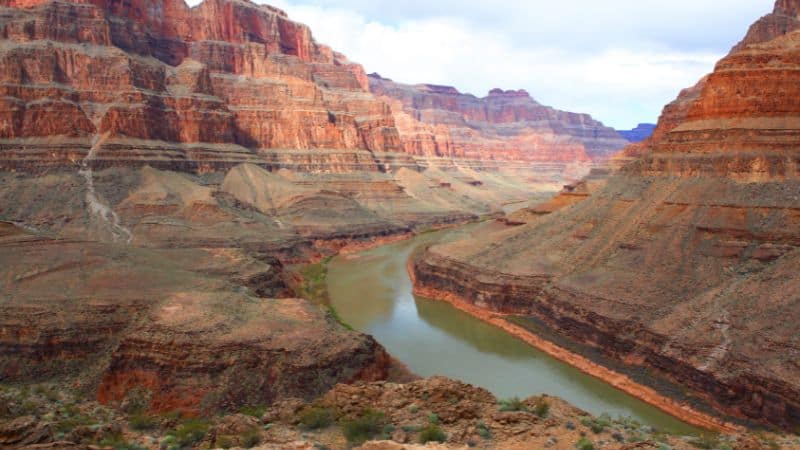
The Grand Canyon’s status as a fascinating tourist destination grew with the advent of railroad access and an increased fascination with the American West. Visitors from all over the world traveled long distances to view this natural wonder, fascinated by its majesty. Finally, the Grand Canyon was declared as a national park in 1919, solidifying its place as a treasured part of the American landscape. Since then, it has welcomed millions of tourists each year, attracting explorers, nature lovers, and curious souls ready to be immersed in its breathtaking embrace.
As you stand on the Grand Canyon’s rim today, you are transported across time, witnessing a harmonious blend of geological wonders, ancient human history, and a rich tapestry of cultural legacy. The Grand Canyon is a tribute to nature’s timeless beauty and enduring power, as well as the wonderful wonders that unfold when geology and time collide.
What to see and where to go on a Grand Canyon Road Trip?
When taking a road trip to the Grand Canyon, there are three primary rims that should be on your itinerary: the South Rim, the North Rim, and the East Rim. The South Rim is the most visited since it is the most easily accessible and it provides visitors with the opportunity to participate in a variety of activities and enjoy stunning perspectives. The North Rim of the Grand Canyon is less busy and more remote than the South Rim. It also has a wider choice of hiking paths and more serene panoramas. The East Rim is the least developed and provides an experience that is more raw and distant than the other rims.
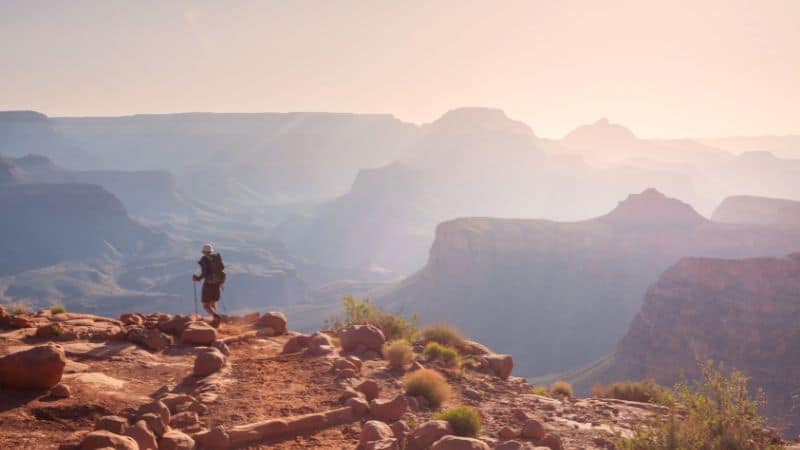
The Grand Canyon is a well-known destination for hikers of various skill levels and abilities, and it features a diverse network of hiking paths. The steep topography and shifting heights of the Grand Canyon National Park make for a diverse range of hiking options, as well as a potentially taxing but ultimately gratifying experience for hikers. The Grand Canyon is a national park in the United States. One of the most well-known trails is the South Kaibab Trail, which is renowned for its breathtaking scenery as well as its challenging inclines and descents. Other famous trails include the Bright Angel Trail, which provides breathtaking perspectives of the canyon and the Colorado River. It is critical that you come prepared for your hike by packing a lot of water, a variety of food, and clothing and equipment that are suited for the weather. It is also a good idea to check with the park ranger station to find out the current state of the trails, since certain paths might be hazardous or blocked due to the weather or other causes.
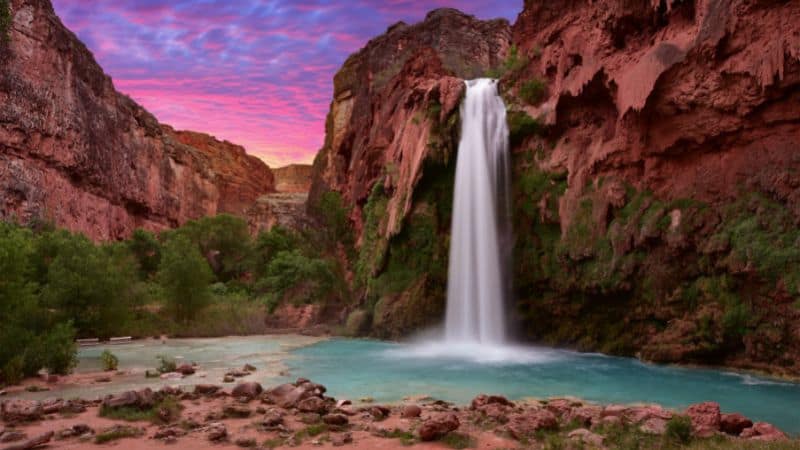
Within the Havasupai Indian Reservation in the Grand Canyon lies the route to Havasu Falls. You must go to the town of Supai, which lies close to the Grand Canyon’s southwest rim, in order to access the trailhead. The 10-mile journey to the waterfall begins there. Wear strong shoes because the largely level, well-marked track may be very rough in certain spots. The average person needs 4-5 hours to accomplish the hike, so make sure to allow enough time and pack lots of water and food. You will be rewarded with breathtaking views of the cliffs and the azure seas when you get at the falls. It should be noted that camping is permitted nearby, but you must first receive a permission from the Havasupai Tribe.
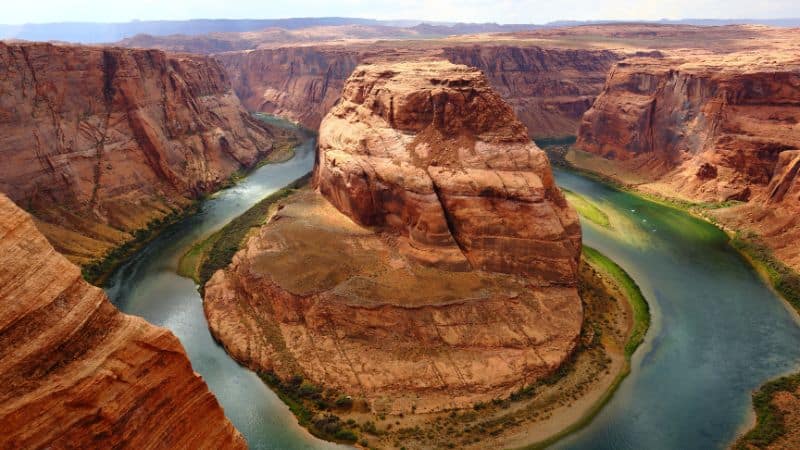
Horseshoe Bend, a well-known tourist destination close to the town of Page, Arizona, is located farther east along the Grand Canyon. Its name comes from the Colorado River’s remarkable horseshoe bend. From a parking spot off of Route 89, you must trek a brief quarter-mile to reach there. All ages and fitness levels may use the route because it is reasonably flat and simple to follow. You’ll be treated to breathtaking views of the river and the surrounding canyon walls as you get to the bend. The region is well-known for its stunning hues and expansive vistas, making it a well-liked location for photography. Bear in mind that Horseshoe Bend does not have guardrails, so use caution when exploring the region.
How long should Grand Canyon Road Trip be?
Choosing the best length for your Grand Canyon road trip is akin to attempting to capture the essence of this natural beauty in a single glance—it’s a challenge that takes considerable thought. While a quick trip to the Grand Canyon might still leave you speechless, giving yourself enough time to explore this magnificent area is the key to having a truly remarkable experience.
While it is feasible to visit the Grand Canyon in a single day, we urge you to avoid the desire. Instead, treat yourself to the luxury of immersing yourself in the attraction of this national treasure. A minimum of two to three days is required to thoroughly appreciate the spectacular scenery, participate in the numerous activities available, and connect with the profound spirit of the canyon.
Timing is critical in deciding the optimum time to visit the Grand Canyon. The spring and fall months emerge as the preferred seasons, with warmer temperatures and less crowds than the busy summer months. Spring brings a blast of color as brilliant wildflowers blossom throughout the terrain, while October casts a golden glow over the canyon as the foliage begins to change. These seasons create a great backdrop for your tour, allowing you to take in the canyon’s solitude and majesty.
Consider allocating your first day to exploring the South Rim, the most accessible and popular rim, while preparing your itinerary. This landmark viewing point offers a plethora of perspectives and pathways that reveal the canyon’s beauty from various angles. Stroll along the rim, taking in the panoramic views and taking in the sheer scale of the chiseled cliffs that plummet into the depths below. Don’t miss the spectacular dawn or sunset, when the canyon is bathed in an ethereal pallet of colors that defies conception.
On your second day, visit the North Rim for a more peaceful and solitary experience. The journey may be a little longer, but the results are well worth the effort. The North Rim is a hiker’s paradise, with a plethora of routes winding through unspoiled wilderness, affording incomparable seclusion and stunning views. This rim allows you to immerse yourself in nature’s embrace and experience periods of calm meditation, with fewer tourists and a serene ambience.
Extend your excursion to the East Rim, the least built and most rugged of the rims, if time allows. The intrepid traveler will be rewarded with raw, untamed beauty in this pristine area. The East Rim provides a sense of isolation and a chance to dig further into the canyon’s mysteries, allowing visitors to experience the untamed soul of this natural beauty.
As you plan the length of your road trip, keep in mind that the Grand Canyon’s allure is not just in its scenic magnificence, but also in the variety of activities it provides. Hiking, camping, river rafting, and helicopter tours all give a new dimension to your visit, allowing you to form a profound connection with this ancient beauty.
Where to stay on a Grand Canyon Road Trip?
Along the route, there are a variety of places to stay, including hotels, motels, and camping, among other possibilities. The Grand Canyon Lodge on the North Rim, the Yavapai Lodge on the South Rim, and the Trailer Village RV Park, which provides full hookups for recreational vehicles, are three of the most popular places to stay in the area.
Those who are considering a road trip to the Grand Canyon have their choice of numerous different campsites to stay in throughout their stay. Mather Campground, Desert View Campground, and North Rim Campground are the names of the three built campsites that are located inside of the national park. These campsites provide a variety of facilities, such as bathrooms, drinking water, and picnic tables, for campers to use during their stays. Because the campgrounds frequently reach capacity, especially during the busiest times of the year for tourists, it is strongly advised that reservations be made in advance.
There are a number of campsites that are privately owned located in close proximity to the national park. These campgrounds could provide a more extensive selection of facilities and opportunities. It is a good idea to conduct some research and compare the many campgrounds in order to choose the one that caters to your requirements and preferences the most.
One further possibility is to camp in style by glamping when visiting the Grand Canyon. There is no glamping accessible within the limits of Grand Canyon National Park; however, there are various possibilities for glamping in the surrounding area that provide guests with experiences that are one-of-a-kind and unforgettable. Glamping, or glamorous camping, has been increasingly popular in recent years. One example of such a resort is Under Canvas Grand Canyon, which is situated only on the outskirts of the Grand Canyon National Park and has opulent tent lodgings complete with private toilets. There is also the Grand Canyon Western Ranch, which provides guests with a variety of Cowboy style glamping options. These include everything from fully-furnished luxury tents to traditional log cabins.
What to pack for a Grand Canyon Road Trip?
It is essential to make detailed travel plans and thoughtful packing decisions before setting out on a road trip to the Grand Canyon. A sufficient amount of water, sunscreen, food, and a map of the park should all be brought along, in addition to any essential camping equipment. Before beginning your trip, it is recommended that you first verify both the weather prediction and the current state of the roads.
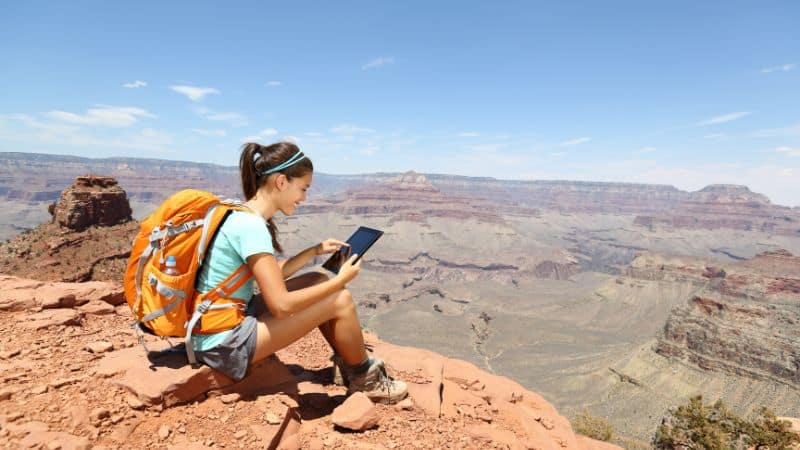
The following items should be included in your travel bag if planning a Grand Canyon Road Trip:
Clothing: It is recommended that visitors bring a wide selection of comfortable and adaptable clothing that may be layered, as the climate at the Grand Canyon is known to be somewhat variable. This could include a light jacket or a raincoat, in addition to a hat and sunscreen for sun protection.
Footwear: Exploring the Grand Canyon requires that you wear shoes that are not only comfortable but also robust, since some of the routes may be rather rugged and rocky. You might want to think about bringing some hiking boots or sneakers with you, in addition to some sandals or flip-flops for wearing about camp or at the resort.
Toiletries: Do not forget to pack your amenities, including your toothbrush, toothpaste, soap, and any prescriptions you may require while you are away. You should also carry bug repellent with you to the Grand Canyon because there are sometimes mosquitoes and other pesky insects there.
Food and water: It is a smart idea to include some non-perishable food and snacks for your road trip, as well as a cooler with ice to keep beverages and perishable foods fresh while you are on the road. When hiking in the Grand Canyon, it is important to stay hydrated, therefore you should be sure to pack lots of water with you.
Camera: Do not forget to carry a camera or a smartphone with you to the Grand Canyon so that you may record the breathtaking views there. Bringing along a compact portable charger is another option for keeping your electronic gadgets fueled up while you are traveling.
Maps and Guides: It is recommended that you carry a map or guidebook of the Grand Canyon with you in order to assist you in planning your excursions and activities while you are there. You may get a map of the park at the visitor center, or you can download one from the website of the National Park Service.
Additional necessities: A first-aid kit, a torch, a pair of binoculars, and a compact backpack designed specifically for carrying your gear on a hike are some of the additional items that you will want to bring with you when hiking.
Directions to the Grand Canyon
From Las Vegas: Take I-15 North to US-93 North to get to the Grand Canyon from Las Vegas in your own vehicle. To get to Grand Canyon National Park from Tusayan, head north on US-93 until you reach AZ-64 east. From there, take exit 165 off of I-40 east. The trip by car takes roughly 4.5 hours to complete and is approximately 275 miles in distance.
From Phoenix: To get from Phoenix to the Grand Canyon, you can take Route 17 north to Flagstaff, then Route 180 north to Valle, and finally Route 64 east to the park entrance. The total distance is about 230 miles and the drive typically takes around four hours, depending on traffic and road conditions.
Grand Canyon Road Trip Map
Do you need to purchase a pass for the Grand Canyon?
You need to buy a park pass to get into the Grand Canyon National Park. The park pass costs a fee per vehicle and lets you go to the park for seven days straight. The price of the pass depends on what kind of pass you get.
There are many different kinds of park passes, including the following:
Individual Pass: This pass lets one person walk or ride a bike into the park. Each person will have to pay $20.
Private Vehicle Pass: This pass lets the driver and all passengers of one private, non-commercial vehicle into the park. Each car will have to pay $35.
Motorcycle Pass: This pass lets the driver and any passengers on one motorcycle into the park. Each bike will cost you $30.
Annual Pass: This pass lets you go to the Grand Canyon National Park for a year after you buy it. Each pass costs $70.
Special Passes: Additionally, there are special passes for seniors, disabled persons and for military. Please check the NPS website for additional information.
You can buy a park pass at any of the entrance stations or on the National Park Service website. Most pass holders will get a physical pass that they have to put in their car. But you can buy some passes as mobile passes that you can use on a mobile device.
It’s important to know that the park pass does not cover camping fees or other fees that may be needed for certain activities or areas in the park. You might have to pay extra for camping, tours with a guide, or other activities. You can get more information at the park’s visitor center or on the National Park Service website.
A Grand Canyon Road Trip will undoubtedly leave an unforgettable mark on you, regardless of how long you decide to spend exploring it on your road trip. Why not start arranging your trip today and see for yourself the wonderful natural marvel.
World Traveling Blogger, Social Media Expert and Nerd who has a passion for Adventure and Fitness.
